Download
1. “Distributed acoustic sensing using dark fiber for near-surface characterization and broadband seismic event detection.” Ajo-Franklin, J.B., Dou, S., Lindsey, N.J., Monga, I., Tracy, C., Robertson, M., Rodriguez Tribaldos, V., Ulrich, C., Freifeld, B., Daley, T. and Li, X., 2019. Scientific reports, 9(1), pp.1-14.
link: https://www.nature.com/articles/s41598-018-36675-8#citeas
“In this paper is presented one of the first case studies demonstrating the use of distributed acoustic sensing deployed on regional unlit fiber-optic telecommunication infrastructure (dark fiber) for broadband seismic monitoring of both near-surface soil properties and earthquake seismology. The study presents 7 months of passive seismic data on a 27km section of dark fiber stretching from West Sacramento, CA to Woodland, CA. This dataset was processed to extract surface wave velocity information using ambient noise interferometry techniques; the resulting VS profiles were used to map both shallow structural profiles and groundwater depth, thus demonstrating that basin-scale variations in hydrological state could be resolved using this technique. The same array was utilized for detection of regional and tele-seismic earthquakes and evaluated for long period response using records from the M8.1 Chiapas, Mexico 2017, Sep 8th event. The combination of these two sets of observations conclusively demonstrates that regionally extensive fiber-optic networks can effectively be utilized for a host of geoscience observation tasks at a combination of scale and resolution previously inaccessible.”

Figure 1. Map of a section of the ESNet Dark Fiber Testbed (https://www.es.net/network-r-and-d/experimentalnetwork-testbeds/100g-sdn-testbed/terms-and-conditions/)

Figure 7. (a) Locations and focal mechanisms of the M4.2 2018-Jan-18 Geysers (red) and M4.4 2018-Jan-04 Berkeley (blue) earthquakes, which occurred approximately 100 km from the Sacramento Dark Fiber DAS array (black line). (b,c) Raw and lowpass fltered DAS strain-rate waveforms for these events averaged over 100m (50 channels) at the yellow circle position shown in (a) (channel 4975+/−50 channels).
2. “Field testing of fiber-optic distributed acoustic sensing (DAS) for subsurface seismic monitoring.” Daley, T.M., Freifeld, B.M., Ajo-Franklin, J., Dou, S., Pevzner, R., Shulakova, V., Kashikar, S., Miller, D.E., Goetz, J., Henninges, J. and Lueth, S., 2013. The Leading Edge, 32(6), pp.699-706.
link: https://library.seg.org/doi/full/10.1190/tle32060699.1
“In this paper, a series of field tests examining the application of this methodology in borehole and surface measurements. These tests are all part of CO2 storage monitoring pilots and use the prototype acquisition system, iDAS, developed by Silixa (Miller et al.). The first test was undertaken at a site operated by the Southeast Carbon Sequestration Partnership (SECARB), a U.S. Department of Energy (DOE) funded pilot in storage and monitoring of anthropogenic carbon within an oil field operated by Denbury Resources in Citronelle, Alabama. The second test was part of the Otway sequestration pilot project operated by the CO2CRC research organization near Warrnambool, Victoria, Australia. The third test was at the Ketzin, Germany, pilot storage site currently operated by the German Research Centre for Geosciences (GFZ). In this article, we focus on the DAS data collected and the initial results from each test. Taken together, these three tests demonstrate many potential applications of DAS technology, as well as some current limitations in sensitivity as compared with conventional geophone recording. Our testing includes both borehole and surface cable data.”

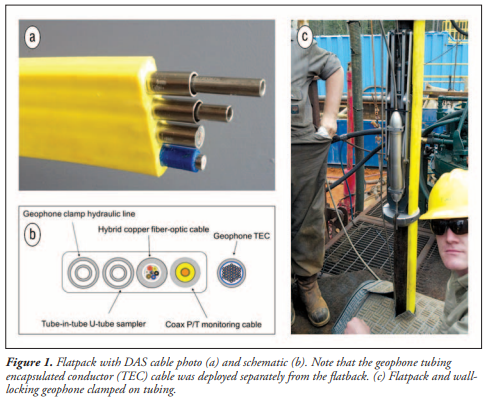
3. “Fiber-optic underground sensor networks.” Soga, K., Kechavarzi, C., Pelecanos, L., de Battista, N., Williamson, M., Gue, C.Y., Di Murro, V., Elshafie, M., Monzón-Hernández Sr, D., Bustos, E. and García, J.A., 2018. In Underground sensing (pp. 287-356). Academic Press.
link: https://www.sciencedirect.com/science/article/pii/B9780128031391000060
In this paper, most current fiber-optic technologies are reviewed, that are capable of point or semi distributed measurement of contaminants or environmental indices by strategic placement of the sensing or monitoring devices at locations of concern. These include those used for gas and emissions detection, sensing and quantifying various indices and toxic chemicals and biological substances in water and soil. “The main motives driving the trend toward increased implementation of structural monitoring systems are the need for structural health monitoring of existing and ageing structures and the desire for a better understanding of increasingly complex designs through performance monitoring of new structures. In the UK, much of the existing infrastructure is old and no longer fit for purpose; indeed, the Institution of Civil Engineers in its State of the Nation Infrastructure 2014 reported that none of the sectors analyzed were “fit for the future” and only one sector was “adequate for now.” The problem is, however, that global and ageing infrastructure worldwide requires monitoring and remedial interventions in order to extend life and prevent catastrophic failures. There is also a progressive need to be able to increase the load and usage of existing structures, be that number of passengers carried, numbers of vehicles or volume of water used.”
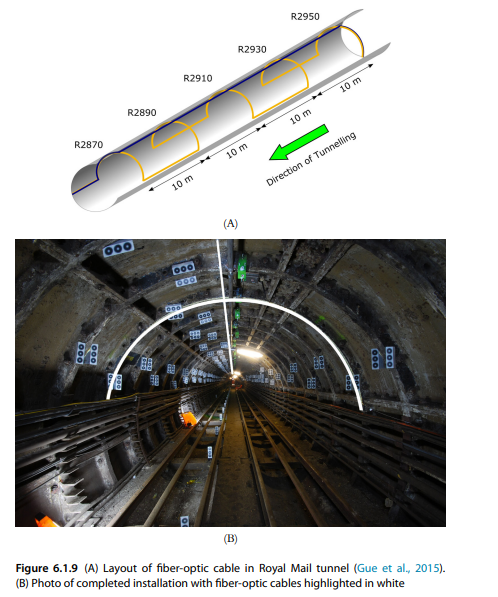
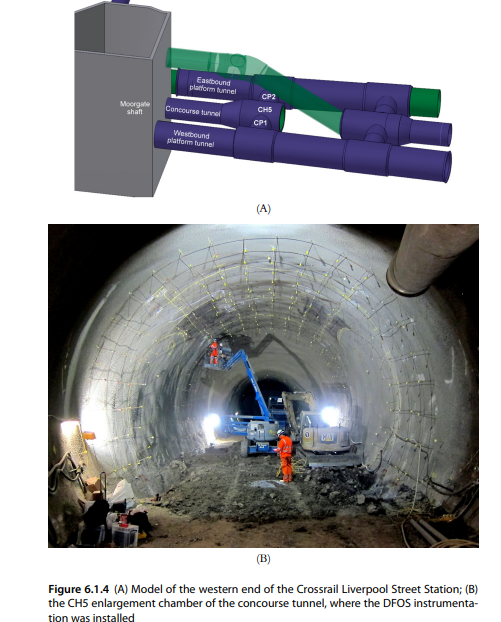
4. “Monitoring of strain and temperature in an open pit using Brillouin distributed optical fiber sensors.” Lanciano, C. and Salvini, R., 2020. Sensors, 20(7), p.1924.
link: https://www.mdpi.com/1424-8220/20/7/1924
“In this paper, some results of an innovative analysis method based on the combination of Distributed Optical Fiber Sensors (DOFS), digital photogrammetry through Unmanned Aerial Vehicle (UAV), topographic, and geotechnical monitoring systems are reviewed. Although DOFS are currently widely used for studying infrastructures, buildings and landslides, their use in rock marble quarries represents an element of peculiarity. The complex morphologies and the intense temperature range that characterize this environment make this application original. The selected test site is the Lorano open pit which is located in the Apuan Alps (Italy); here, a monitoring system consisting of extensometers, crackmeters, clinometers and a Robotic Total Station has been operating since 2012. From DOFS measurements, strain and temperature values were obtained and validated with displacement data from topographic and geotechnical instruments. These results may provide useful fundamental indications about the rock mass stability for the safety at work and the long-term planning of mining activities.”
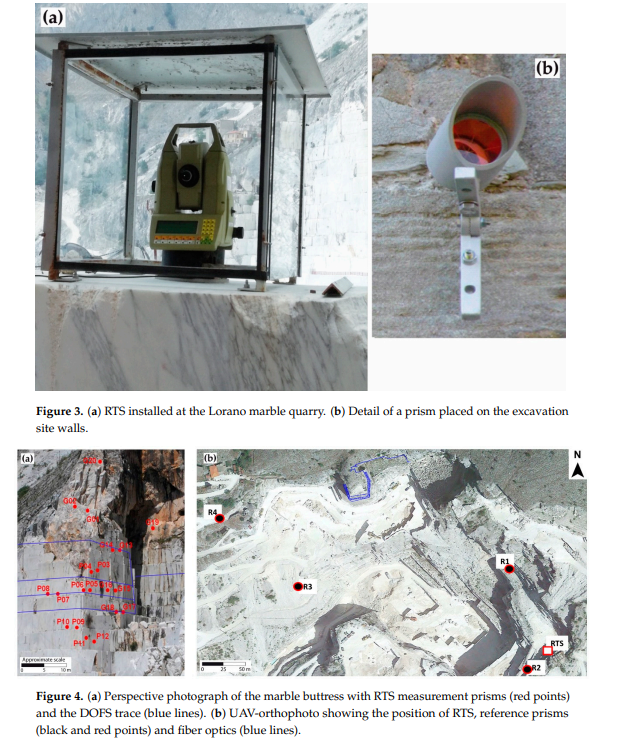

5. “Distributed fiber optic sensing of land deformation: Methods and case studies.” Zhang, C.C., Shi, B. and Soga, K., 2019. In Geo-Congress 2019: Engineering Geology, Site Characterization, and Geophysics (pp. 188-196). Reston, VA: American Society of Civil Engineers.
link: https://ascelibrary.org/doi/epdf/10.1061/9780784482131.020
“This paper introduces the principle of the distributed fiber optic sensing technology with a particular emphasis on Brillouin optical time domain reflectometry and explores its application in two cases (groundwater-related land subsidence in the southern Yangtze Delta and reservoir-induced landslide in the Three Georges Reservoir region) in China. Initial conclusions suggest that this technology can complement with conventional methods for improved monitoring of land deformation. The ability to obtain a complete subsurface strain profile with a single fiber optic cable could improve our ability to constrain analyses and forecast future land deformation.”
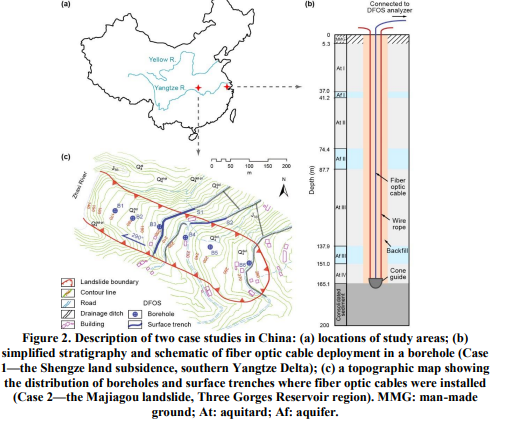
6. “Fiber optic deployment challenges and their management in a developing country: A tutorial and case study in Ghana.” Nyarko‐Boateng, O., Xedagbui, F.E.B., Adekoya, A.F. and Weyori, B.A., 2020 Engineering Reports, 2(2), p.e12121.
link: https://onlinelibrary.wiley.com/doi/full/10.1002/eng2.12121
“This research seeks to investigate the challenges in fiber cable deployment in Ghana, with emphasis on the technical, regulatory, managerial challenges and recommend the appropriate solutions. The challenges of frequent fiber cuts can be attributed to external factors such as dig-ups during road construction. Lack of regulatory guidelines and policies on fiber deployment and management poses a major threat to the fiber management in Ghana.”
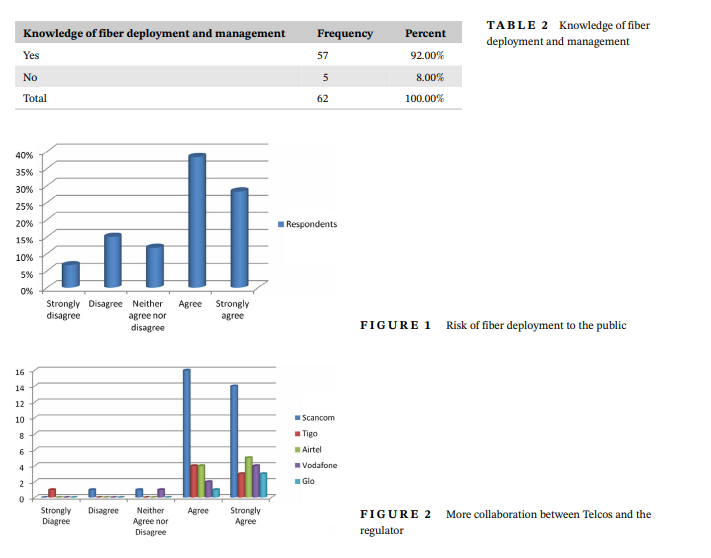
7. “Distributed strain behavior of a reinforced concrete bridge: Case study.” Regier, R. and Hoult, N.A., 2014. Journal of Bridge Engineering, 19(12), p.05014007.
link: https://ascelibrary.org/doi/epdf/10.1061/%28ASCE%29BE.1943-5592.0000637
“This case study investigates the performance of a distributed fiber optic strain measurement technology with high accuracy and spatial resolution during a load test on a RC bridge. The measurements from the fiber optic system are compared with conventional strain gauges and linear transducers, and good agreement between the sensors was found. The fiber optic measurements are also used to examine the bridge support conditions as well as the load distribution between beams. The results show that assumptions made about the support conditions during design do not match the actual bridge behavior, although the load distribution between beams is as expected. To investigate the potential of using distributed FOS for bridge monitoring, a trial system was installed on an in-service RC bridge near the town of Madoc in Ontario, Canada, known as the Black River Bridge. This paper presents a background to fiber optic monitoring, the Black River Bridge field site, and the load test and installed instrumentation, as well as a discussion of the measurement results and the response of the bridge.”

8. “Embedded distributed optical fiber sensors in reinforced concrete structures—A case study.” Barrias, A., Casas, J.R. and Villalba, S., 2018. Sensors, 18(4), p.980.
Link: https://www.mdpi.com/1424-8220/18/4/980
“When using distributed optical fiber sensors (DOFS) on reinforced concrete structures, a compromise must be achieved between the protection requirements and robustness of the sensor deployment and the accuracy of the measurements both in the uncracked and cracked stages and under loading, unloading and reloading processes. With this in mind the authors have carried out an experiment where polyimide-coated DOFS were installed on two concrete beams, both embedded in the rebar elements and also bonded to the concrete surface. The specimens were subjected to a three-point load test where after cracking, they are unloaded and reloaded again to assess the capability of the sensor when applied to a real loading scenario in concrete structures. Rayleigh Optical Frequency Domain Reflectometry (OFDR) was used as the most suitable technique for crack detection in reinforced concrete elements. To verify the reliability and accuracy of the DOFS measurements, additional strain gauges were also installed at three locations along the rebar. The results show the feasibility of using a thin coated polyimide DOFS directly bonded on the reinforcing bar without the need of indention or mechanization.”


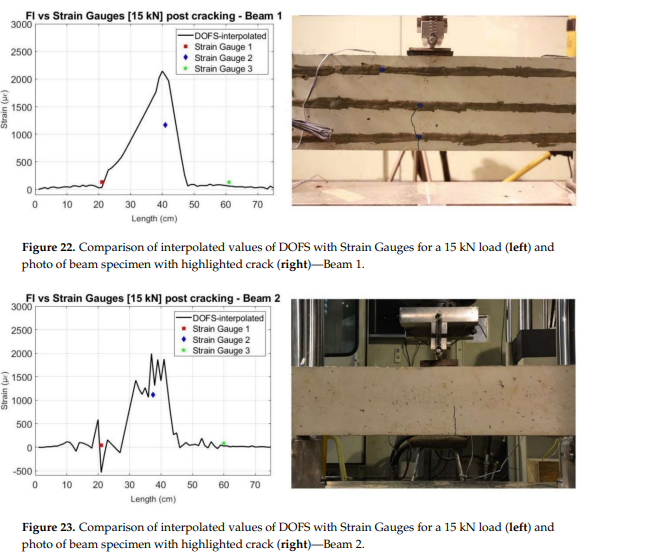
9. “Monitoring the behavior of segment joints in a shield tunnel using distributed fiber optic sensors.” Wang, X., Shi, B., Wei, G., Chen, S.E., Zhu, H. and Wang, T., 2018. Structural Control and Health Monitoring, 25(1), p.e2056.
Link: https://onlinelibrary.wiley.com/doi/abs/10.1002/stc.2056
“In this work, to monitor shield tunnels and ensure performance and safety, fiber optic sensing technique is proposed. Based on Brillouin optical frequency domain analysis, the technique can monitor the opening and closing of segmental joints in shield tunnels with high sensitivity. To determine tunnel lining segment displacement, different fixed‐point spacings have been tested in the lab. The test results show that the difference in fixed‐point distances had no impact on the test accuracy and the sensing cable with 0.9‐mm polyurethane sheath coater has the best performance. For demonstration, the Brillouin optical frequency domain analysis‐based monitoring technique is applied to the Suzhou Metro Line 1 tunnel for tunnel lining segment joint monitoring. The technique detected minor deformation of the segment joints in tunnels in operation and located leakages within the tunnel. The technique further identified that the minor deformations of the segment joints and track bed expansion were closely associated with temperature variations.”

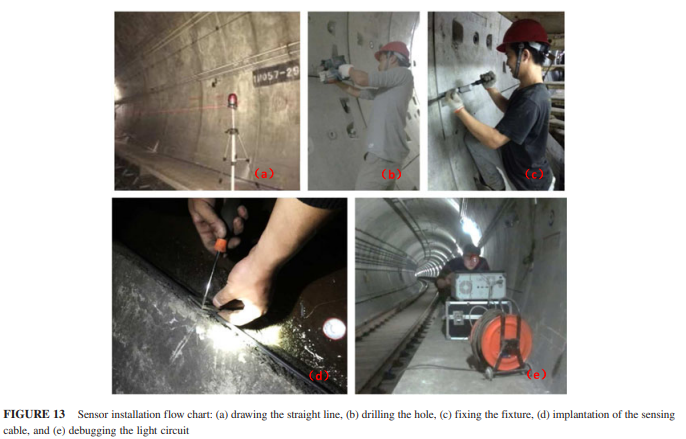

10. “Deployment of a smart structural health monitoring system for long-span arch bridges: A review and a case study. “ Chen, Z., Zhou, X., Wang, X., Dong, L. and Qian, Y., 2017. Sensors, 17(9), p.2151.
Link: https://www.mdpi.com/1424-8220/17/9/2151
“The paper reviews the recent progress of the SHM technology that has been applied to long-span bridges. The deployment of a SHM system is introduced. Subsequently, the data analysis and condition assessment including techniques on modal identification, methods on signal processing, and damage identification were reviewed and summarized. A case study about a SHM system of a long-span arch bridge (the Jiubao bridge in China) was systematically incorporated in each part to advance our understanding of deployment and investigation of a SHM system for long-span arch bridges. The applications of SHM systems of long-span arch bridge were also introduced. From the illustrations, the challenges and future trends for development a SHM system were concluded.”


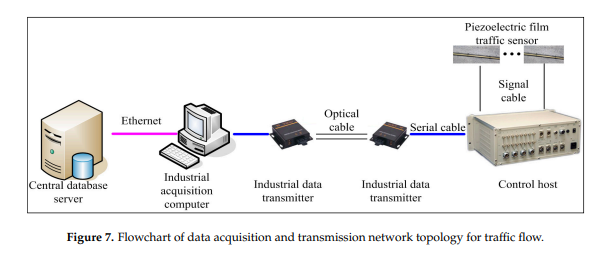
www.dastsensing.net
